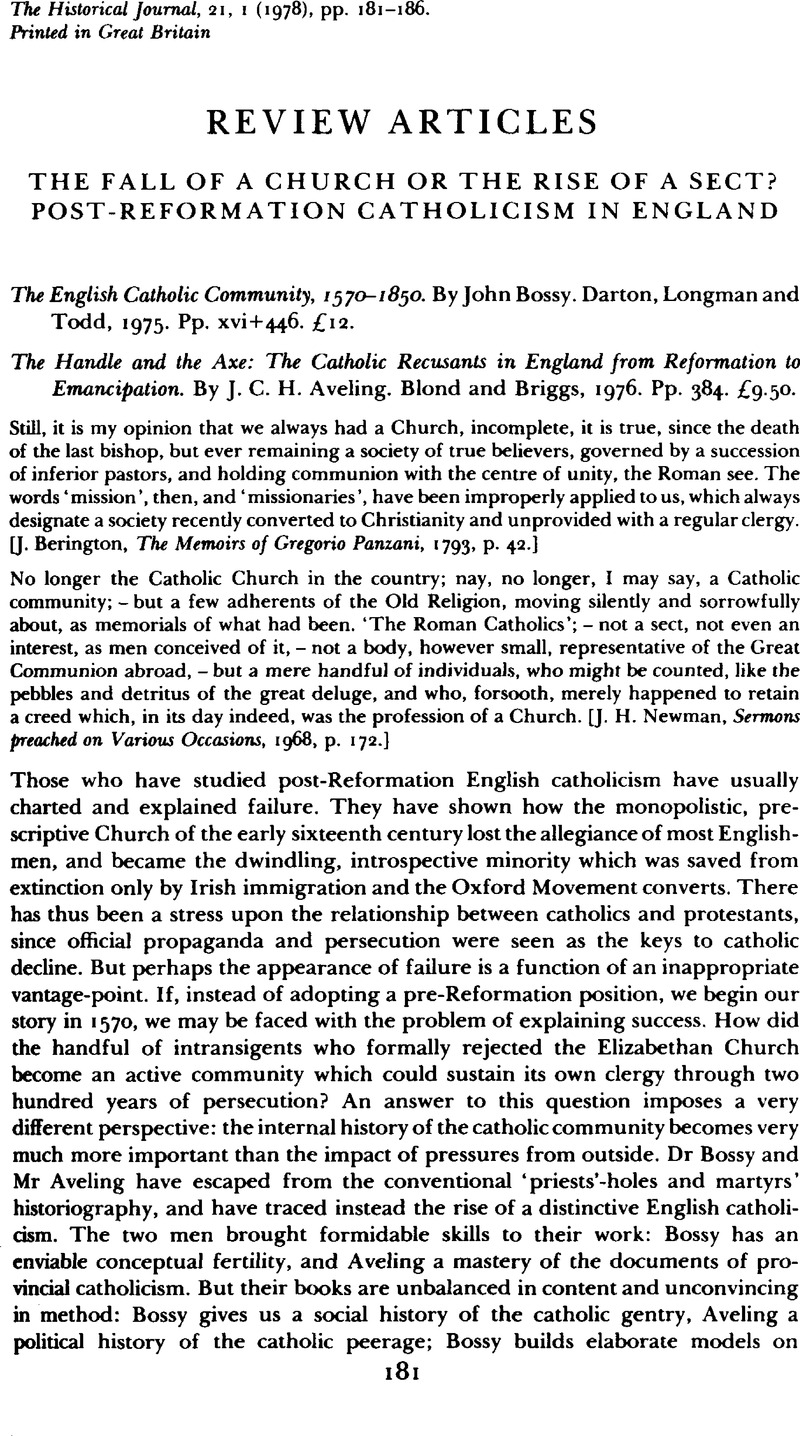Article contents
The Fall of a Church or the Rise of a Sect? Post-Reformation Catholicism in England
Published online by Cambridge University Press: 11 February 2009
Abstract

- Type
- Review Articles
- Information
- Copyright
- Copyright © Cambridge University Press 1978
References
1 In four chapters on the period 1603–60 Aveling devotes 37 pages to the regular clergy, 11 to the seculars, 19 to Court Catholicism, 22 to the gentry and 1 page to the commons.
2 Aveling has some sympathy for this view, but is more cautious and has a greater awareness of the elements of continuity (Handle and the axe, pp. 19–20, 36, 42–9, 52, 60, 64–6).
3 Newman, , Sermons on various occasions, p. 169.Google Scholar
4 It is significant that Bossy cites few of the theses produced by the massive recusant-industry, which has specialized in the dissection of lists produced by the Exchequer fining system and diocesan visitations.
5 Aveling, H., Post-Reformation Catholicism in east Yorkshire, 1558–1790 (East Yorkshire Local History Series, xi, 1960), 28.Google Scholar
6 Catholic Record Society, ii, 183–4; xxxix, 61, 320.
7 Weiner, C. Z., ‘The Beleaguered Isle: a study of Elizabethan and early Jacobean anti-Catholicism’, Past and present, li, 42–6, 49–50Google Scholar; Haigh, C., ‘Puritan evangelism in the reign of Elizabeth I’, English Historical Review, xcii, 31, 46–54.Google Scholar For the view of a despondent magistrate, see Catholic Record Society, xxxix, p. xxvii.
8 Bossy's picture of increasing numbers of catholics seems to me a direct result of a serious exaggeration of the efficiency of recusant detection in 1603 and 1640. The main problems of uncovering catholics at visitation are indicated in Manning, R. B., Religion and society in Elizabethan Sussex (1969), pp. 23–5Google Scholar; Paul, J. E., ‘Hampshire recusants in the time of Elizabeth I’, Proceedings of the Hampshire Field Club, xxi, 72–3Google Scholar; Aveling, J. C. H., Catholic recusancy in the city of York, 1558–1791 (Catholic Record Society, Monograph Series, ii 1970). pp. 80–1Google Scholar; Haigh, C., Reformation and resistance in Tudor Lancashire (1975), pp. 230–2, 267–75.Google Scholar
9 Aveling, , Handle and the axe, p. 193Google Scholar; Aveling, H., Northern Catholics: the Catholic Recusants of the North Riding of Yorkshire, 1558–1790 (1966), p. 285Google Scholar; Miller, J., Popery and politics in England, 1660–1688 (1973), pp. 16, 19Google Scholar; Kenyon, J., The Popish plot (1972), p. 26.Google Scholar
10 I hope to discuss the issues of continuity and the size, structure and distribution of post-Reformation Catholicism in more detail elsewhere.
- 4
- Cited by


